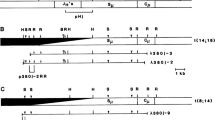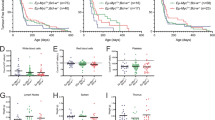Abstract
The tumour suppressor p53 transcriptionally regulates a range of target genes that control cell growth and survival. Mutations of p53 have been implicated in the development of ∼50% of human cancers, including those instigated by exposure to mutagens. Although numerically rare, cancers can arise as a consequence of inherited mutations, such as in the Li–Fraumeni syndrome, which is caused by mutation of one p53 allele. Gene-targeted mice deficient for p53 have been generated to study this familial cancer syndrome. On a C57BL/6 background, p53-deficient mice develop primarily thymic lymphoma and more rarely sarcoma. Evasion of apoptosis is considered to be essential for neoplastic transformation. As proteins of the Bcl-2 family are the critical regulators of apoptosis, we investigated the role of the pro-survival members Bcl-2, Bcl-xL and Bcl-w in cancer development in p53+/− and p53−/− mice by testing whether ABT-737, a pharmacological inhibitor of these proteins, could prevent or delay tumourigenesis. Our studies showed that ABT-737 prophylaxis only caused a minor delay and reduction in γ-radiation-induced thymic lymphoma development in p53−/− mice, but this was accompanied by a concomitant increase in sarcoma. These data show that, collectively, Bcl-2, Bcl-xL and Bcl-w have only minor roles in thymic lymphoma development elicited by defects in p53, and this may indicate that Mcl-1 and/or A1 may feature more prominently in this process.
Similar content being viewed by others
Log in or create a free account to read this content
Gain free access to this article, as well as selected content from this journal and more on nature.com
or
Abbreviations
- qRT-PCR:
-
quantitative PCR
- FACS:
-
fluorescence-activated cell sorting
- FCS:
-
fetal calf serum
- DMSO:
-
dimethyl sulphoxide
- BSS:
-
balanced salt solution
- CL:
-
cell line
- wt:
-
wild type
- Ctrl:
-
control value
- WBC:
-
white blood cell count
- Eμ-myc/rv-bcl-2:
-
Eμ-myc B lymphoma cells that had been retrovirally transduced with a Bcl-2 expression construct
References
Srivastava S, Zou ZQ, Pirollo K, Plattner W, Chang EH . Germline transmission of a mutated p53 gene in a cancer-prone family with Li–Fraumeni syndrome. Nature 1990; 348: 747–749.
Malkin D, Li FP, Strong LC, Fraumeni JFJ, Nelson CE, Kim DH et al. Germ line p53 mutations in a familial syndrome of breast cancer, sarcomas, and other neoplasms. Science 1990; 250: 1233–1238.
Donehower LA, Harvey M, Slagle BL, McArthur MJ, Montgomery CAJ, Butel JS et al. Mice deficient for p53 are developmentally normal but are susceptible to spontaneous tumours. Nature 1992; 356: 215–221.
Jacks T, Remington L, Williams BO, Schmitt EM, Halachmi S, Bronson RT et al. Tumor spectrum analysis in p53-mutant mice. Curr Biol 1994; 4: 1–7.
Olive KP, Tuveson DA, Ruhe ZC, Yin B, Willis NA, Bronson RT et al. Mutant p53 gain of function in two mouse models of Li–Fraumeni syndrome. Cell 2004; 119: 847–860.
Vousden KH, Lane DP . p53 in health and disease. Nat Rev Mol Cell Biol 2007; 8: 275–283.
Hotchkiss RS, Strasser A, McDunn JE, Swanson PE . Cell death. N Engl J Med 2009; 361: 1570–1583.
Hanahan D, Weinberg RA . The hallmarks of cancer. Cell 2000; 100: 57–70.
Youle RJ, Strasser A . The BCL-2 protein family: opposing activities that mediate cell death. Nat Rev Mol Cell Biol 2008; 9: 47–59.
Green DR, Kroemer G . The pathophysiology of mitochondrial cell death. Science 2004; 305: 626–629.
Huang DCS, Strasser A . BH3-only proteins – essential initiators of apoptotic cell death. Cell 2000; 103: 839–842.
Lessene G, Czabotar PE, Colman PM . BCL-2 family antagonists for cancer therapy. Nat Rev Drug Discov 2008; 7: 989–1000.
Oltersdorf T, Elmore SW, Shoemaker AR, Armstrong RC, Augeri DJ, Belli BA et al. An inhibitor of Bcl-2 family proteins induces regression of solid tumours. Nature 2005; 435: 677–681.
Park CM, Bruncko M, Adickes J, Bauch J, Ding H, Kunzer A et al. Discovery of an orally bioavailable small molecule inhibitor of prosurvival B-cell lymphoma 2 proteins. J Med Chem 2008; 51: 6902–6915.
Mason KD, Vandenberg CJ, Scott CL, Wei AH, Cory S, Huang DC et al. In vivo efficacy of the Bcl-2 antagonist ABT-737 against aggressive Myc-driven lymphomas. Proc Natl Acad Sci USA 2008; 105: 17961–17966.
Cragg MS, Harris C, Strasser A, Scott CL . Unleashing the power of inhibitors of oncogenic kinases through BH3 mimetics. Nat Rev Cancer 2009; 9: 321–326.
Cory S, Huang DC, Adams JM . The Bcl-2 family: roles in cell survival and oncogenesis. Oncogene 2003; 22: 8590–8607.
Kaplan HS, Brown MB . Further observations on inhibition of lymphoid tumor development by shielding and partial-body irradiation of mice. J Natl Cancer Inst 1951; 12: 427–436.
Kemp CJ, Wheldon T, Balmain A . p53-deficient mice are extremely susceptible to radiation-induced tumorigenesis. Nat Genet 1994; 8: 66–69.
Michalak EM, Vandenberg CJ, Delbridge ARD, Wu L, Scott CL, Adams JM et al. Apoptosis-promoted tumorigenesis: gamma-irradiation-induced thymic lymphomagenesis requires Puma-driven leukocyte death. Genes Dev 2010; 24: 1608–1613.
Labi V, Erlacher M, Krumschnabel G, Manzl C, Tzankov A, Pinon J et al. Apoptosis of leukocytes triggered by acute DNA damage promotes lymphoma formation. Genes Dev 2010; 24: 1602–1607.
Strasser A, Harris AW, Jacks T, Cory S . DNA damage can induce apoptosis in proliferating lymphoid cells via p53-independent mechanisms inhibitable by Bcl-2. Cell 1994; 79: 329–339.
Strasser A, Harris AW, Cory S . Bcl-2 transgene inhibits T cell death and perturbs thymic self-censorship. Cell 1991; 67: 889–899.
Motoyama N, Kimura T, Takahashi T, Watanabe T, Nakano T . bcl-x prevents apoptotic cell death of both primitive and definitive erythrocytes at the end of maturation. J Exp Med 1999; 189: 1691–1698.
Bouillet P, Cory S, Zhang L-C, Strasser A, Adams JM . Degenerative disorders caused by Bcl-2 deficiency are prevented by loss of its BH3-only antagonist Bim. Dev Cell 2001; 1: 645–653.
Print CG, Loveland KL, Gibson L, Meehan T, Stylianou A, Wreford N et al. Apoptosis regulator Bcl-w is essential for spermatogenesis but appears otherwise redundant. Proc Natl Acad Sci USA 1998; 95: 12424–12431.
O’Reilly LA, Print C, Hausmann G, Moriishi K, Cory S, Huang DCS et al. Tissue expression and subcellular localization of the pro-survival molecule Bcl-w. Cell Death Differ 2001; 8: 486–494.
Opferman JT, Letai A, Beard C, Sorcinelli MD, Ong CC, Korsmeyer SJ . Development and maintenance of B and T lymphocytes requires antiapoptotic MCL-1. Nature 2003; 426: 671–676.
Opferman J, Iwasaki H, Ong CC, Suh H, Mizuno S, Akashi K et al. Obligate role of anti-apoptotic MCL-1 in the survival of hematopoietic stem cells. Science 2005; 307: 1101–1104.
Bouillet P, Metcalf D, Huang DCS, Tarlinton DM, Kay TWH, Köntgen F et al. Proapoptotic Bcl-2 relative Bim required for certain apoptotic responses, leukocyte homeostasis, and to preclude autoimmunity. Science 1999; 286: 1735–1738.
Villunger A, Michalak EM, Coultas L, Müllauer F, Böck G, Ausserlechner MJ et al. p53- and drug-induced apoptotic responses mediated by BH3-only proteins Puma and Noxa. Science 2003; 302: 1036–1038.
Cragg MS, Jansen ES, Cook M, Strasser A, Scott CL . Treatment of B-RAF mutant human tumor cells with a MEK inhibitor requires Bim and is enhanced by a BH3 mimetic. J Clin Invest 2008; 118: 3651–3659.
Mandal M, Borowski C, Palomero T, Ferrando AA, Oberdoerffer P, Meng F et al. The BCL2A1 gene as a pre-T cell receptor-induced regulator of thymocyte survival. J Exp Med 2005; 201: 603–614.
Kaufmann T, Tai L, Ekert PG, Huang DC, Norris F, Lindemann RK et al. The BH3-only protein bid is dispensable for DNA damage- and replicative stress-induced apoptosis or cell-cycle arrest. Cell 2007; 129: 423–433.
Acknowledgements
We thank Abbott Laboratories and Genentech Inc. for providing us with ABT-737; Dr. T Jacks for p53-deficient mice; Drs. LA O’Reilly and DC Huang, and Mr. ARD Delbridge, for advice and reagents; K McKenzie, G Siciliano, N Iannarella, L Reid and K Vella for expert animal care; B Helbert and C Young for genotyping; J Corbin for automated blood analysis; E Tsui, V Babo, K Weston, Y Hoang and S Hasanein for histology, and D Quilici, T Nikolaou and G Thomas for γ-irradiation. This work was supported by grants and fellowships from the Cancer Council of Victoria (to PNK), the National Health and Medical Research Council (Program Grant no. 461221; NHMRC Australia Fellowship), the NIH (CA43540) and the Leukemia and Lymphoma Society (SCOR Grant no. 7413), University of Melbourne International Research Scholarship, University of Melbourne International Fee Remission Scholarship, Cancer Therapeutics CRC Top-up Scholarship (last three to SG) and operational infrastructure grants through the Australian Government IRISS and the Victorian State Government OIS.
Author information
Authors and Affiliations
Corresponding author
Ethics declarations
Competing interests
The authors declare no conflict of interest.
Additional information
Edited by S Kaufmann
Supplementary Information accompanies the paper on Cell Death and Differentiation website
Rights and permissions
About this article
Cite this article
Grabow, S., Waring, P., Happo, L. et al. Pharmacological blockade of Bcl-2, Bcl-xL and Bcl-w by the BH3 mimetic ABT-737 has only minor impact on tumour development in p53-deficient mice. Cell Death Differ 19, 623–632 (2012). https://doi.org/10.1038/cdd.2011.133
Received:
Revised:
Accepted:
Published:
Issue date:
DOI: https://doi.org/10.1038/cdd.2011.133
Keywords
This article is cited by
-
BCL-w: apoptotic and non-apoptotic role in health and disease
Cell Death & Disease (2020)
-
BCL2 and miR-15/16: from gene discovery to treatment
Cell Death & Differentiation (2018)
-
Survival rates of homozygotic Tp53 knockout rats as a tool for preclinical assessment of cancer prevention and treatment
Cellular & Molecular Biology Letters (2017)
-
Role of miR-15/16 in CLL
Cell Death & Differentiation (2015)
-
The oncogenic properties of EWS/WT1 of desmoplastic small round cell tumors are unmasked by loss of p53 in murine embryonic fibroblasts
BMC Cancer (2013)



